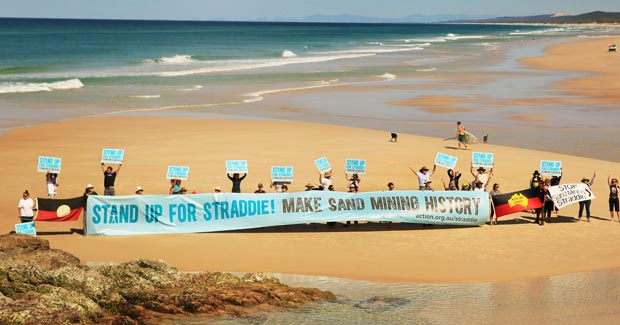Plan to expand sandmining on Stradbroke

ENVIRONMENTAL GROUPS, TRADITIONAL OWNERS and local residents gathered on North Stradbroke Island in Queensland this week to protest a government proposal to expand the island’s sandmining operations.
The event was organised by the Australian Conservation Foundation (ACF) as part of their “Stand up for Straddie: make sandmining history” campaign.
The ACF is concerned that if elected, the Coalition will give state governments the power to make federal environmental decisions. This would make it easier for the Queensland Government to expand existing mines on North Stradbroke Island until at least 2035.
Sandmining on North Stradbroke Island
Current legislation states that heavy mineral mining on the island, including the operations of the lucrative Sibelco’s Enterprise mine, must end in 2019 when 80 per cent of the island will be declared a national park. The area will then be jointly managed by the island’s traditional owners, the Quandamooka people and the Queensland Government.
However, the new proposal would allow the state government to make approvals on the Federal Government’s behalf on matters of national environment significance, says Jess Abrahams, a campaigner with the ACF. “It is a terrible precedent; it’s like putting the fox in charge of the henhouse,” he says.
North Stradbroke Island is the world’s second largest sand island. Located about 30km south-east of Brisbane, it provides habitat for a number of rare and endangered species, including the Wallum sedge frog (Litoria olongburensis). The island also comprises globally recognised wetlands, which provide important feeding and nesting sites for local and migratory birds.
“An extension of mining on Stradbroke Island threatens the internationally listed wetlands, which are within metres of the mine,” says Jess. “We are concerned about the impact this will have on threatened species.”
Impacts of mining on ecosystems
The launch of the “Stand up for Straddie” campaign follows the release of an independent scientific report that assesses the hydrological impacts of the Enterprise mine. The report was prepared by hyrdrologist Dr Errol Stock and commissioned by Friends of Stradbroke Island, a local environment-protection organisation. It states that the mine could be responsible for “a substantial and measurable change in the hydrological regime of the wetland”.
“Water is the lifeblood of the island,” says Dr Jan Aldenhoven, a marine biologist and Stradbroke resident. “It has a large influence on the diversity of habitats that we see here.”
Jan hopes the campaign will draw national attention to the issue of sandmining on North Stradbroke Island and help to ensure a more sustainable future for the region. “Mining is the past,” she says. “While the government keeps talking about extending mining, they’re not progressing other things that are for our future, such as education, the arts and research. They need to get on with managing the national park; establishing walking trails and boardwalks.”
Quandamooka traditional owner Darren Burns agrees. “The sooner mining stops, the better,” he says. “We’ve already lost so much; we don’t want to lose any more of our natural and cultural resources to mining.”
RELATED STORIES

